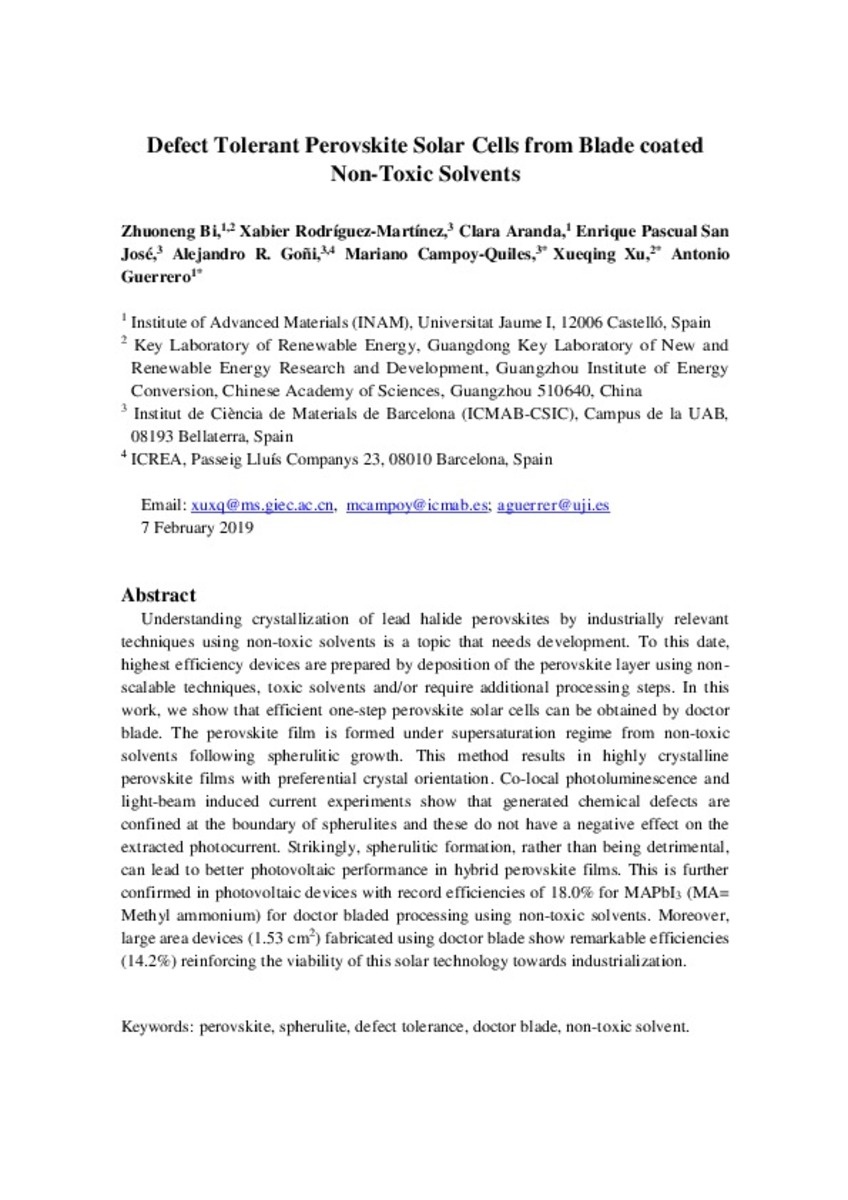Mostrar el registro sencillo del ítem
Defect tolerant perovskite solar cells from blade coated non-toxic solvents
| dc.contributor.author | Bi, Zhuoneng | |
| dc.contributor.author | Rodríguez-Martínez, Xabier | |
| dc.contributor.author | Aranda Alonso, Clara | |
| dc.contributor.author | Pascual-San-José, Enrique | |
| dc.contributor.author | Goñi, Alejandro R. | |
| dc.contributor.author | XU, XUEQING | |
| dc.contributor.author | Guerrero, Antonio | |
| dc.date.accessioned | 2019-02-11T11:35:50Z | |
| dc.date.available | 2019-02-11T11:35:50Z | |
| dc.date.issued | 2018-09 | |
| dc.identifier.citation | BI, Zhuoneng, et al. Defect tolerant perovskite solar cells from blade coated non-toxic solvents. Journal of Materials Chemistry A, 2018, 6.39: 19085-19093. | ca_CA |
| dc.identifier.uri | http://hdl.handle.net/10234/180942 | |
| dc.description.abstract | The process of crystallization of lead halide perovskites by industrially relevant techniques involving non-toxic solvents is not understood completely and needs improvement. To this date, devices with the highest efficiency are prepared by deposition of the perovskite layer using non-scalable techniques, toxic solvents and/or require additional processing steps. In this work, we show that perovskite solar cells can be obtained efficiently in one step by doctor blade. The perovskite film is formed under a supersaturation regime from non-toxic solvents following spherulitic growth. This method results in highly crystalline perovskite films with preferential crystal orientation. Co-local photoluminescence and light-beam induced current experiments show that the generated chemical defects are confined at the boundary of spherulites and do not have a negative effect on the extracted photocurrent. Strikingly, spherulite formation, rather than being detrimental, could lead to better photovoltaic performance in hybrid perovskite films. This is further confirmed in the photovoltaic devices, which were fabricated using non-toxic solvents by doctor blade process, with record efficiencies of 18.0% for MAPbI3 (MA = methyl ammonium). Moreover, devices with large area (1.53 cm2) fabricated using doctor blade show remarkable efficiencies (14.2%) reinforcing the viability of this solar technology towards industrialization. | ca_CA |
| dc.format.extent | 8 p. | ca_CA |
| dc.format.mimetype | application/pdf | ca_CA |
| dc.language.iso | eng | ca_CA |
| dc.publisher | Royal Society of Chemistry | ca_CA |
| dc.rights | © The Royal Society of Chemistry 2018 | ca_CA |
| dc.rights.uri | http://rightsstatements.org/vocab/InC/1.0/ | * |
| dc.subject | perovskite | ca_CA |
| dc.subject | spherulite | ca_CA |
| dc.subject | defect tolerance | ca_CA |
| dc.subject | doctor blade | ca_CA |
| dc.subject | non-toxic solvent | ca_CA |
| dc.title | Defect tolerant perovskite solar cells from blade coated non-toxic solvents | ca_CA |
| dc.type | info:eu-repo/semantics/article | ca_CA |
| dc.identifier.doi | http://dx.doi.org/10.1039/C8TA06771F | |
| dc.relation.projectID | Spanish Ministerio de Economía y Competitividad (MINECO) (MAT2016-76892-C3-1-R, MAT2015-70850-P (HIBRI2), (Ramón y Cajal Fellowship number RYC-2014-16809), (Spanish Severo Ochoa Centre of Excellence (ICMAB), Grant No. SEV-2015-0496) ; ollaborative Innovation and Environmental Construction Platform of Guangdong Province (2014A050503051) ; University Jaume I (UJI-B2017-32) ; European Research Council (ERC) (grant agreement no. 648901). | ca_CA |
| dc.rights.accessRights | info:eu-repo/semantics/openAccess | ca_CA |
| dc.relation.publisherVersion | https://pubs.rsc.org/en/content/articlehtml/2018/ta/c8ta06771f | ca_CA |
| dc.type.version | info:eu-repo/semantics/submittedVersion | ca_CA |
Ficheros en el ítem
Este ítem aparece en la(s) siguiente(s) colección(ones)
-
INAM_Articles [503]







